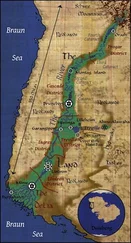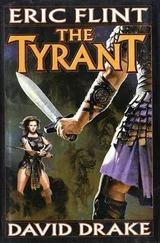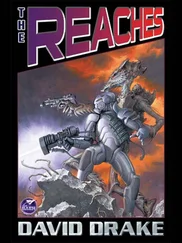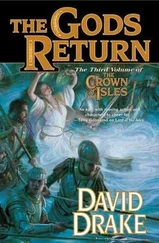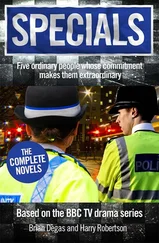That was a gentle reminder to Lahti, not that she was out of line asking. With Herod shut down, she had nothing to see but the sky—white rather than really blue—and the sides of the gully.
Buntz had a 270°sweep of landscape centered on the Government firebase thirty klicks to the west. His external pickup was pinned to a tree on the ridge between Herod and Hole Card , feeding the helmet displays of both tank commanders through fiber-optic cables.
There were sensors that could maybe spot the pickup, but it wouldn't be easy and even then they'd have to be searching in this direction. The Brotherhood wasn't likely to be doing that when they had the Government battalion and five Slammers combat cars to hold their attention on the rolling grasslands below.
The Placidan troops were in a rough circle of a dozen bunkers connected by trenches. In the center of the encampment were four 15-cm conventional howitzers aiming toward the Spine from sandbagged revetments. The trenches were shallow and didn't have overhead cover; ammunition trucks were parked beside the guns without even the slight protection of a layer of sandbags.
According to the briefing materials,the firebase also had two calliopes whose task was to destroy incoming shells and missiles. Those the Placidan government bought had eight barrels each, arranged in superimposed rows of four.
Buntz couldn't see the weapons on his display. That meant they'd been dug in to be safe from direct fire, the only decision the Placidan commander'd made that he approved of. Two calliopes weren't nearly enough to protect a battalion against the kind of firepower a Brotherhood commando had available, though.
The combat cars of 3d Platoon, G Company, were laagered half a klick south of the Government firebase. The plains had enough contour that the units were out of direct sight of one another. That wouldn't necessarily prevent Placidans from pointing their slugthrowers up in the air and raining projectiles down on the Slammers, but at least it kept them from deliberately shooting at their mercenary allies.
Buntz' pickup careted movement on the foothills of the Spine to the north. "Helmet," he said, enabling the voice-activated controls. "Center three-five-oh degrees, up sixteen."
The magnified image showed the snouts of three air-cushion vehicles easing to the edge of the evergreen shrubs on the ridge nearly twenty kilometers north of the Government firebase. One was a large armored personnel carrier; it could carry fifteen fully armed troops plus its driver and a gunner in the cupola forward. The APC's tribarrel was identical to the weapons on the Slammers' combat cars, a Gatling gun which fired jets of copper plasma at a rate of 500 rounds per minute.
The other two vehicles were tank destroyers. They used the same chassis as the APC, but each carried a single 9-cm high intensity powergun in a fixed axial mount—the only way so light a vehicle could handle the big gun's recoil.At moderate range—up to five klicks or so—a 9-cm bolt could penetrate Herod 's turret, and it'd be effective against a combat car at any distance.
"Saddle up, trooper," Buntz said softly to Lahti as he dropped down into the fighting compartment. "Don't crank her till I tell you, but we're not going to have to wait till noon after all. They're taking the bait."
The combat cars didn't have a direct view of the foothills, but like Buntz they'd raised a sensor pickup; theirs was on a pole mast extended from Lieutenant Rennie's command car. A siren wound from the laager; then a trooper shot off a pair of red flare clusters. Rennie was warning the Government battalion—which couldn't be expected to keep a proper radio watch—but Buntz knew that Platoon G3's main task was to hold the Brotherhood's attention. Flares were a good way to do that.
The Government artillerymen ran to their howitzers from open-sided tents where they'd been dozing or throwing dice. Several automatic weapons began to fire from the bunkers. One was on the western side of the compound and had no better target than the waving grass. The guns shooting northward were pointed in the right direction, but the slugs would fall about fifteen kilometers short.
The Brotherhood tank destroyers fired, one and then the other. An ammunition truck in the compound blew up in an orange flash. The explosion dismounted the nearest howitzer and scattered the sandbag revetments of the other three, not that they'd been much use anyway. A column of yellow-brown dirt lifted, mushroomed a hundred meters in the air, and rained grit and pebbles down onto the whole firebase.
The second 9-cm bolt lashed the crest of the rise which sheltered the combat cars. Grass caught fire and glass fused from silica in the soil sprayed in all directions. Buntz nodded approval. The Brotherhood gunner couldn't have expected to hit the cars, but he was warning them to keep under cover.
Brotherhood APCs slid out of the shelter of the trees and onto the grasslands below. They moved in companies of four vehicles each, two east of the firebase and two more to the west. They weren't advancing toward the Government position but instead were flanking it by more than five kilometers to either side.
The sound of the explosion reached Herod , dulled by distance. A little dirt shivered from the side of the swale. Twenty klicks is a hell of a long way away, even for an ammo truck blowing up.
The tank destroyers fired again, saturated cyan flashes that Buntz' display dimmed to save his eyes. Their target was out of his present magnified field of view, a mistake.
"Full field, Quadrant Four," Buntz said, and the lower left corner of his visor showed the original 270° display. A bunker had collapsed in a cloud of dust though without a noticeable secondary explosion, and there was a new fire just north of the combat cars. The cars' tribarrels wouldn't be effective against even the tank destroyers' light armor at this range, but the enemy commander wasn't taking any chances. The Brotherhood was a good outfit, no mistake.
Eight more vehicles left the hills now that the advanced companies had spread to screen them. Pairs of mortar carriers with pairs of APCs for security followed each flanking element. The range of Brotherhood automatic mortars was about ten klicks, depending on what shell they were firing. It wouldn't be any time before they were in position around the firebase.
Rennie's combat cars were moving southward, keeping under cover. Running, if you wanted to call it that.
The Brotherhood APCs were amazingly fast, seventy kph cross-country. They couldn't fight the combat cars head-on, but they wouldn't try to. They obviously intended to surround the Slammers platoon and disgorge their infantry in three-man buzzbomb teams. Once the infantry got into position, and with the tank destroyers on overwatch to limit the cars' movement, the Brotherhood could force Lieutenant Rennie to surrender without a shot.
One of the Government howitzers fired. The guns could reach the Brotherhood vehicles in the hills, but this round landed well short. A red flash and a spurt of sooty black smoke indicated that the bursting charge was TNT.
Читать дальше


